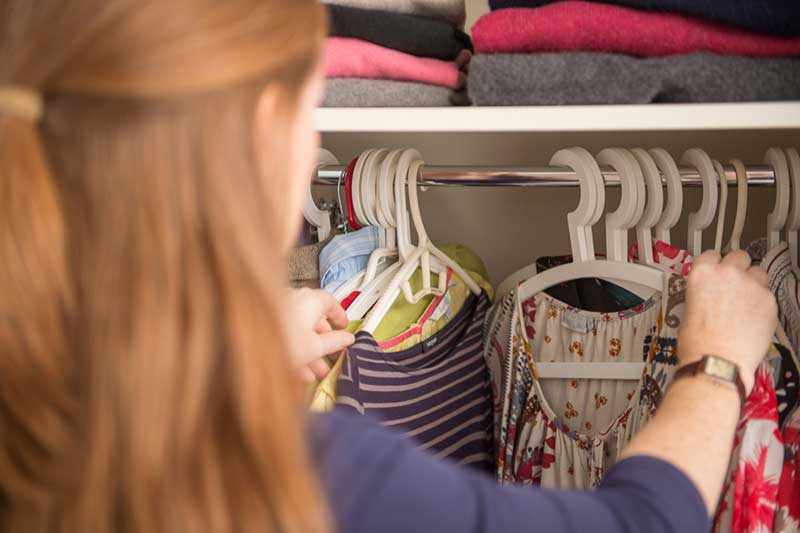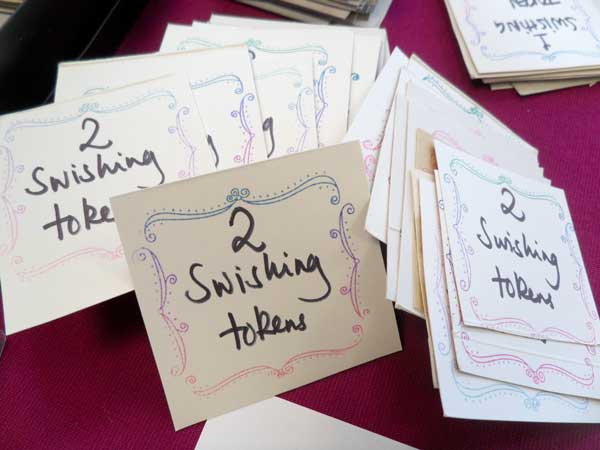- What is swishing
- Why swish
- So you want to run a swish
- Step 1
- Step 2
- Step 3
- Step 4
- Step 5
- A few final suggestions
- Resources
- Latest events (on Facebook)
-
This guide has been produced by the
West London Waste Authority





You’re itching to know more, aren’t you? Like how one of these events would actually work? Your standard Swish will come in three parts: 1) the drop off, 2) the sort and 3) the opening of the Swish.
During the drop off time the Swishers (guests of the Swish) go to the venue to drop off their items. The Swisher exchanges clothes for tokens which are used to ‘buy’ their new-to-them wardrobe.
All the items swapped for tokens are sorted onto hangers and put out across clothing rails ready for the opening of the Swish. The time during the sorting is ideal for entertainment or refreshments.
Once everything has been sorted the Swish is declared open, and the shopping begins! Swishers check out the range of items hanging on the rails looking for great new outfits to take away with them, while they say goodbye as their old clothes go off to a new home. Having made their choices Swishers then hand back the tokens in exchange for some delightful new additions to their wardrobe.
The secret is out – we love clothes! The average household owns £4,000 worth of clothing, 30% of which have not been worn in the past year. Estimates put the value of this unused clothing at around £30 billion. Don’t you think it’s time to start getting some of that value back?


Swishing is a fun and social way of encouraging people to make the most of what they’ve got hanging in their wardrobe, sitting in a drawer or packed away in a box.
While our pockets benefit from Swishing, so do our bins. Textiles make up around 3% of the average household bin in the UK. In West London alone it’s estimated that almost 9,000 tonnes of textiles end up in our bins or bags. If we reuse or recycle these items instead we could save a whopping 39 million tonnes of carbon!
Swishing events can be held almost anywhere, be it at home with your friends, at your office with your co-workers or at a community hall for anyone to attend.
This guide covers all you need to know to get you Swishing. The following pages will take you through five simple steps to organise your Swish, from planning right through to the event.
Step 1 – Let’s get planning
In this first step you will answer some vital questions to work out the essentials of your event.
Step 2 – The particulars
Building on your essentials, this step is about running your successful Swish.
Step 3 – The cherry on top
This step is all about the little extras, the things that will make your event one to remember.
Step 4 – Call to Swish
Enough planning – it’s time to get things booked and begin spreading the word.
Step 5 – It’s Swishing time
A plan to guide you through the set-up, things to do during the event and what to do when it’s all over. Although we would advise taking a peek before the day itself!
If you’re in west London we (the West London Waste Authority) are able to help with Swishing events within our partner boroughs (Brent, Ealing, Harrow, Hillingdon, Hounslow and Richmond). We have all the equipment you need for a basic event (i.e. clothes rails, hangers, mirrors, tokens etc.) and can provide further information about organising the extra touches. Having run a number of events across west London we have the expertise to help your event go without a hitch. So if you are thinking of holding a Swish and would like us to help, or even if you just have a question, get in touch with us by emailing info@westlondonwaste.gov.uk.


Where to start? There are a few key questions to answer before beginning to plan your Swishing event. Download the planner resource A to help you keep track of the decisions you make.
Do you want to bring friends together? Perhaps you’re raising money for a good cause or to raise the profile of a local group? Maybe it’s about great fashion on a budget, to encourage a less wasteful society or just for a bit of fun? Knowing why helps set the tone for things to organise, as well as the message you want to promote.
Is the Swish just for family and friends or co-workers, or would you like anyone in the local community to be able to join in? Whose clothes do you want to swap: men’s, women’s, children’s or all of them?
Where to hold this frock frolicking occasion!? After choosing the lucky guests you can then move on to picking out a suitable venue. Perhaps it can take place at home, at work or your local hall. Think about venue size, location and parking! Remember, if you’re hosting it for a community group they might have a room they already use at a discounted rate. You may want to read Step 3 – The Cherry on Top before making your decision.
Who the event targets might dictate an appropriate time or day. If you’re holding the Swish during the week it’s a good idea to have it in the evening after people return from work. A weekend event on the other hand is best done during the day. Before you decide, always check what else is happening on that date – does it clash with any big events or school holidays?

As we know it is all in the details, so get these sorted and you’ll be laughing! Add these particulars in to your planner (resource A) so everyone knows what’s going on.

Unfortunately every now and again you can end up with a disgruntled Swisher so it’s good to let them know where they stand at the start. Explain that they Swish at their own risk! See our template disclaimer in resource J.
An entrance fee is generally only used at community events, to help cover costs of hiring the venue or to raise money for a good cause. The fee should be reasonable, as you don’t want to put people off. If you charge a fee you could consider offering a free drink or raffle ticket to help encourage attendance. If there will be an entrance fee, don’t forget to tell people the amount when you advertise the Swish and put up a sign on the day as a reminder.
Will Swishers be able to drop off items in the lead up to the Swishing event? This is ideal for larger events as long as you have the space for storage, although you need to keep a record so you can give the people the right number of tokens (Swishing currency) on the night of the Swish. A template recording sheet can be printed off from resource F.

Those final few touches can make all the difference. If you’re truly out to make this an event they won’t forget than it’s worth spending a few minutes thinking about the following...
Offering refreshments at the event gives a real sense of occasion. They also occupy Swishers whilst waiting for the moment they can choose their new items. Remember to stay within the law, as you may need a license if you’re looking to sell alcohol. If you’re just looking for donations, refreshments can be a great way to subsidise any event costs or raise money for a charity.
If your location doesn’t have space for Swishers to wait after dropping off their items, is there a nearby café or pub you can guide people to? Contact the owner of the café or pub and explain what you are doing. Maybe you can work out a discount for those coming to the event if you advertise before-hand.
Could you offer beauty treatments or a tailoring service at the event? Adding a pampering element or the ability to have items re-sized may attract more people. Local businesses might offer your Swishers a bit of a discount on the night to help promote their services. Just remember to leave enough space for all the clothes!
A Swish could be the perfect opportunity to help people learn how to love their clothes a little more, or even to love someone else’s! If there’s a keen crafter in the area or a local sewing group see if they can offer their assistance at the event to demonstrate how to turn up a hem, patch up some trousers or customise a jumper. A lot of people would love the opportunity to make their clothes last longer but don’t always have the skills to do so. If there’s no one who can come along why not display some of the Love Your Clothes repair cards (resource L) with easy to understand instructions to sew on buttons, alter hems and other useful fixes.
If you can, create a changing area for people to try the clothes on. This could be in the venue toilets or by curtaining off another area. It’s easier to make a decision about whether an item will really get worn (or not) after seeing it on. We wouldn’t want any more unused items hanging in wardrobes now would we?
Who doesn’t like to rest their bones for a minute or two whilst on the search for a new outfit? It’s also nice to have somewhere to sit before the sprint to the rails to choose your new wardrobe. Try grouping some chairs together near the shoes to make it easier for people to try them on.
It doesn’t have to be fancy, but having a few small decorations can help make the event feel professional. A bit of bunting or a few fairy lights perhaps? At least clear the area and make sure there is enough space between the items on display, have a couple of mirrors around, let the sun in and have music playing in the background.
When people drop off their items record how many items have been brought in and ask Swishers to read and sign the disclaimer. This is useful for any disputes later on and helpful if you want to prove your event was a success. Depending on your reasons for holding the event you may want to record the weight of donated clothes as well as to show how much of a positive environmental benefit you had. Use resources F and G or make your own.
Ask for people’s feedback before they leave the event. You can learn from the feedback for the next time you host a Swish. You can also use the nice comments for future advertising. There’s a sample comments sheet in resource H.
When advertising your event ask people to bring their own bags. Try and have some spare just in case!
Not all the items brought to the Swish end up finding a new home that day. It’s worth having a think about a charity any leftover textiles can go to. Let them know in advance so they can prepare for a delivery – they may even help you promote the event and when you’re asked what will happen to anything left at the end you can promote them too. Work out how the items left at the end will get to the charity shop, it makes clearing up afterwards a bit easier.

Now’s the time to get booking and let everyone know that a Swish is on its way! Check our handy organiser checklist in resource C to make sure nothing gets forgotten.
Get it booked before it goes! Check what the venue requires from you. Do you need to provide an event plan or risk assessment? Health and safety should always be a number one priority. An example risk assessment can be found in resource E.
How you send invitations will depend on who your event is for. If it’s family and friends a phone call may suffice, for co-workers an email. If you’re going big, think about posters, advertising online or creating a press release for the local newspaper. If you are holding it for the community, place a poster at the venue you have chosen. Try and advertise your event as far in advance as possible so it gets a spot in peoples’ diaries!
A good start is to explain briefly what a Swish entails and what will be accepted at the event. Then move on to the important details like venue address, date, time and where they can get more information about the event – a website, the organiser’s phone number or their email address. If you’re planning to offer any additional services at the event it’s good to let Swishers know in advance so they can bring a few extra pennies. See resource D for a template poster.
Remember you’re not Superwoman or Superman. Depending on the size of your Swish you may need a little help: setting up, sorting through, checking in items and then checking them out again. If you can, provide name badges so Swishers can easily identify who to go to for help. Book your helpers in advance or talk to us at West London Waste as we might be able to send one of our own team to a local event.
Having rails and display tables are a necessity for an ultra sleek Swish! Your local charity shops may be able to lend you a couple of rails for the event. For west London events get in touch with us at West London Waste and if ours are free you’re more than welcome to them! On the rails, try and separate clothing into men’s/women’s/children’s and type (jumpers, t-shirts, skirts etc.), and leave space in between the rails so there’s no garment hunting collisions. If you’re not local then see if your local council or local recycling campaign might be able to help you out.


Finally the time has come to help those un-loved clothes find a new home. There‘s a lot to do but the event check list in resource I will help you keep on top of it!
This guide has been produced by the West London Waste Authority. Swishing is supported in the Waste Minimisation Strategy and yearly action plans. This guide, which may be freely downloaded, distributed and copied, is part of the activities in the 2014/15 Waste Prevention Action Plan. Funding was provided by the London Boroughs of Brent, Ealing, Harrow, Hillingdon, Hounslow and Richmond upon Thames.